Fears over the safety of one of Britain’s most popular hair treatments this week caused shockwaves among beauty fans.
US scientists suggested that chemical relaxers used to straighten hair, such as Keratin treatments and Brazilian blowouts, may dramatically raise the risk of certain cancers.
The researchers from Emory University in Georgia, who tracked more than 50,000 women, found those who enjoyed such hair care had a 166 percent higher risk of pancreatic cancer.
Their risk of thyroid cancer, meanwhile, rose to a staggering 71 per cent and non-Hodgkin’s lymphoma, 62 per cent.
This risk was increased further among frequent users — defined as using the products more than four times per year.
It is believed formaldehyde, which is used as a preservative in such hair products, can escape from them as a gas over time, a process known as ‘off-gassing’ — especially when they come into contact with heat.
If these fumes are inhaled repeatedly, they can lead to anything from minor side effects like eye and respiratory irritation to major health issues.
But super strength straightening treatments are not the only hair products that can drastically impact health. Other popular treatments can leave users suffering allergic reactions or even needing skin grafts.
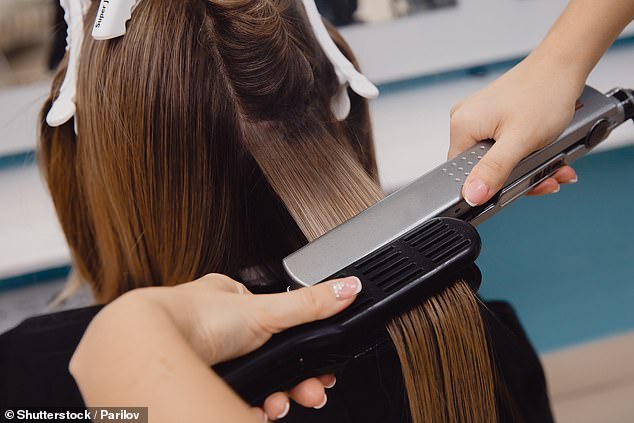
US scientists this week suggested that chemical relaxers used to straighten hair, such as Keratin treatments and Brazilian blowouts, may dramatically raise the risk of certain cancers
Chemical burns from DIY bleaching
For years, women have taken to social media in their droves to share horrifying tales of hair dye jobs gone wrong.
Photos posted online show how some have been forced to have half of their heads shaved or even undergo skin grafts to replace dead skin on the back of their heads.
Others have told how doctors have warned them the hair will never grow back as there are no follicles in the skin.
Chemicals including ammonium, hydrogen peroxide and potassium persulfates are often to blame, experts have claimed.
Hair lightening products containing persulfates and hydrogen peroxide are permitted for use in the EU and UK only after being thoroughly checked for safety.
In the UK, the maximum concentration of hydrogen peroxide allowed for use in hair products is 12 per cent.
Persulfates do not have any specified concentration and hair lightening products may contain up concentrations of 70 per cent, according to the Cosmetic, Toiletry and Perfumery Association (CTPA).
Over a prolonged time, a high-energy reaction, caused when the chemicals come in contact with skin tissue, can destroy human flesh.
Hair restoration on tissue once damaged by burns is complex and can take longer to achieve than typical hair transplant surgery.
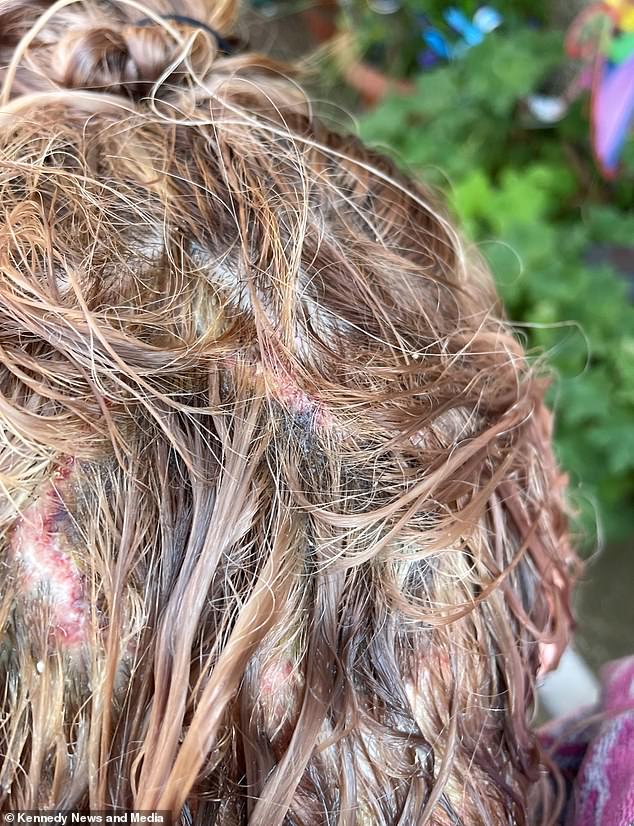
Photos posted online show how some have been forced to have half of their heads shaved or even undergo skin grafts to replace dead skin on the back of their heads
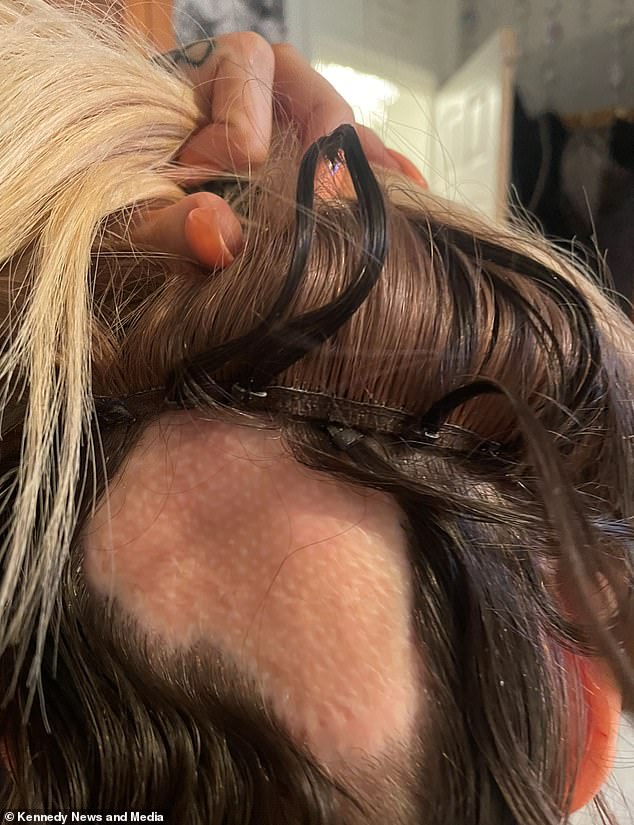
Others have told how doctors have warned them the hair will never grow back as there are no follicles in the skin
Allergies triggering face swelling
Some components in hair dyes can also cause symptoms of an allergic reaction.
This is why manufacturers say a skin tolerance test must be carried out 48 hours before.
Such recommendations are in place for both home dye kits and those used by professionals in hair salons.
Most commonly the chemical paraphenylenediamine (PPD) causes reactions from mild skin irritation to swelling.
In one dramatic case, a woman’s face swelled to twice its size, she suffered a burning scalp and was left with severe breathing difficulties after having an allergic reaction to hair dye.
Paraphenylenediamine, also known as PPD, is one of the most common hair dye ingredients and is found in more than two thirds of products.
Reactions to PPD can range from mild irritation in the scalp to an allergic reaction that can potentially trigger serious symptoms throughout the body.
Often signs include itchiness and swelling but in rarer cases the reaction may trigger a dangerous inflammation of the airways called anaphylaxis.
This can make it hard and even impossible to breath and can cause the body to go into a cardiac emergency like a cardiac arrest due to a lack of oxygen.
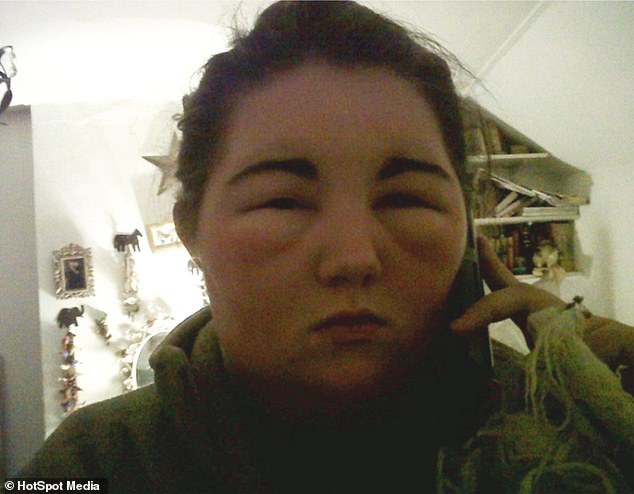
Robyn Cherry from Cheltenham, Gloucestershire, was left unable to see and her face doubled in size after dying her hair brown back in 2010 – despite undergoing a patch test

Doctors discovered Robyn had suffered a severe reaction to paraphenylenediamine (PPD), a common ingredient in hair dye
Hair straighteners and curling tongs
With their inbuilt hot plates often reaching temperatures exceeding 220 degrees, a pair of hair straighteners has the potential to do enormous damage.
The every day styling tools—which work by compressing hair between two electronically heated plates, removing kinks and frizz—don’t just promise poker straight locks.
They can easily cause poker hot burns—and the same goes for curling tongs.
As they take up to 40 minutes to completely cool down after use, experts have urged users to invest in heatproof bags to store them in to keep them out of the way of hands, arms, or stop them from being accidentally sat on while they’re still red hot.
Proper post-use care also keeps them out of harm’s way from children, who have been known to innocently reach up and grab the devices with horrendous outcomes.
According to the Children’s Burns Trust, there was a 20 per cent year-on-year increase in children being admitted to specialist burn units in the first six months of 2023 due to injuries and scalds from hair appliances.
Worryingly, the figure didn’t include less serious burns which were treated at A&E departments.
Because children’s skin is much thinner than adults’, burns can be much more serious, with some children left with life-changing injuries or permanent disfigurement.
Some youngsters have even been left with excruciating third degree burns—which is a burn that affects all of the layers of skin and sometimes the fat and muscle tissue beneath—and needing surgeries and skin grafts.
Ken Dunn, a consultant burns and plastic surgeon and vice chair of The Children’s Burns Trust, said: ‘The increase in hair straightener burns among children is deeply troubling.
‘These injuries are entirely preventable, and it is crucial that parents and caregivers are aware of the risks associated with these devices.
‘Simple steps, such as using heat-resistant pouches and ensuring proper storage, can make a significant difference in protecting our children from these accidents.’
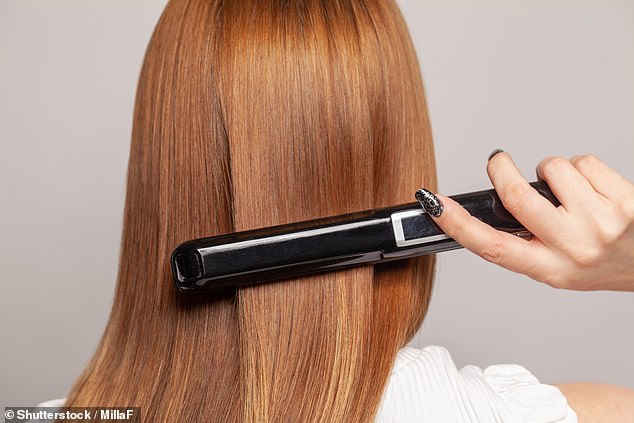
With their inbuilt hot plates often reaching temperatures exceeding 220 degrees, a pair of hair straighteners has the potential to do enormous damage
Shampoos with hidden gluten
People with coeliac disease or gluten intolerance don’t only need to exercise caution at restaurants and during their food shop—washing their hair can also prove dangerous.
Many shampoos contain gluten—a protein naturally found in grains such as wheat, barley and rye—which manufacturers use as a thickening agent, or to add shine to the hair.
While gluten cannot be absorbed through the skin, there is a slight chance that some suds could be accidentally ingested, particularly by young children during a hair wash, and it could trigger a reaction.
US charity and advocacy group the Celiac Disease Foundation says: ‘Gluten cannot be absorbed through your scalp or skin unless there is an open lesion. It must be ingested to affect those with coeliac disease.’
For people with very sensitive skin, eczema or inflammatory skin conditions, gluten does have the potential to cause irritation or allergic reactions, regardless of if you have a sensitivity or allergy to the protein.
To check if your shampoo contains gluten, look for hydrolyzed wheat protein, hydrolyzed vegetable protein or wheat germ oil on the ingredients list.
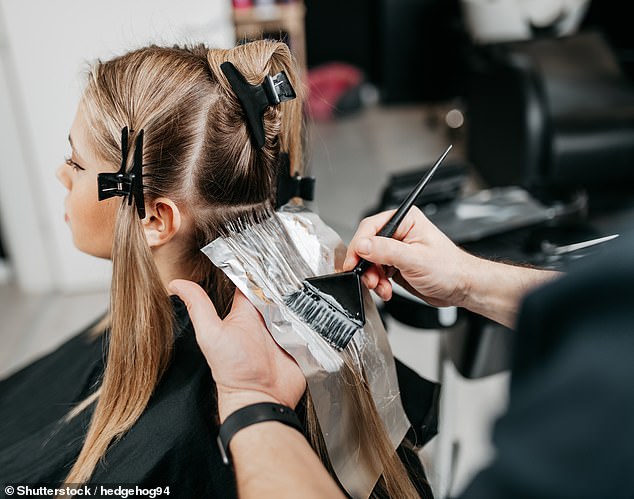
Limited research has also suggested that using hair dye multiple times a year could raise the risk of certain cancers
Limit hair colouring sessions
Limited research has also suggested that using hair dye multiple times a year could raise the risk of certain cancers.
According to one 2017 study by London surgeon Kefah Mokbel, women who colour their hair have a 14 per cent rise in rates of breast cancer.
Professor Mokbel, who works at the Princess Grace Hospital in Marylebone, London, concluded: ‘Although further work is required to confirm our results, our findings suggest that exposure to hair dyes may contribute to breast cancer risk.’
He also recommended that women should dye their hair only two to five times a year and use products with more natural ingredients, such as beetroot, to reduce the risk of cancer.
Meanwhile, another 2008 study found those who use hair dyes more than nine times a year had a 60 per cent greater risk of chronic lymphocytic leukaemia.
And women who regularly used hair dyes before 1980 could be in even greater danger, US researchers said, with a 70 per cent increased risk of developing the blood disease.
This is because dyes sold before then contained toxic ingredients linked to cancer which are not present in modern hair products.
But experts have repeatedly warned that there is not enough evidence yet to prove that repeated hair dyeing does raise the risk.
Chemical hair relaxers
For decades the Black community have used products to reduce their hair’s natural coiled texture and make it easier to style and manage.
These products, known as ‘relaxers’ or perms, are a form of chemical straightener which breaks the hair’s natural curl pattern, leaving it straight.
However, their use has been linked to a string of devastating illnesses and painful burns on the scalp.
Symiah Barnett, a researcher from Reading University, is part of a group carrying out vital research into the hair products marketed towards Black communities.
She told the Daily Mail: ‘Chemical hair relaxers are notorious for causing scalp burns because they typically contain strong alkaline agents such as sodium hydroxide or guanidine hydroxide.
‘These chemicals can disrupt the scalp’s natural pH, leading to chemical burns and inflammation.
‘Despite decades of widespread use, within Black communities, there is surprisingly a lack of research examining their chronic effects, including how these chemicals are absorbed through the scalp or whether they may be linked to broader health outcomes.’
A 2018 study by the Silent Spring Institute, Massachusetts analysed 18 hair products marketed towards black women.
These products were made up of hot-oil treatments, anti-frizz polishes, leave-in conditioners, root stimulators, hair lotions and relaxers.
They found that almost 80 percent of the hair products contained chemicals linked to cancer, infertility and obesity.
Up to 78 percent of relaxers, which are used to permanently straighten hair, contained hormone-disrupting chemicals, known as parabens.
Past studies suggest parabens, which are used as preservatives, mimic oestrogen and may cause cancer, weight gain and reduced muscle mass.
